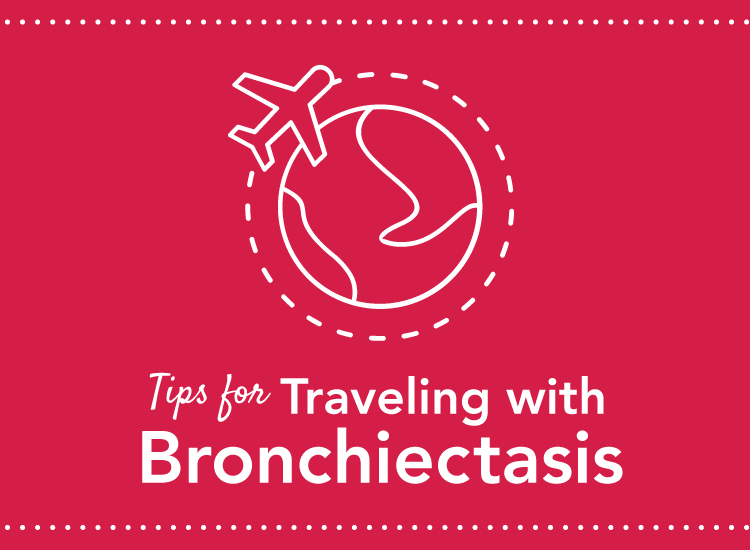 If you’re living with bronchiectasis, air travel may not sound like an ideal method of transportation. Between the plane’s cramped seating, cabin air pressure, and high altitude making it more difficult to breathe, you may avoid flying altogether. But an important part of living with a chronic lung disease, like bronchiectasis, is finding ways to manage its symptoms without compromising your quality of life.
If you’re living with bronchiectasis, air travel may not sound like an ideal method of transportation. Between the plane’s cramped seating, cabin air pressure, and high altitude making it more difficult to breathe, you may avoid flying altogether. But an important part of living with a chronic lung disease, like bronchiectasis, is finding ways to manage its symptoms without compromising your quality of life.
Whether you’re vacationing out of the country or visiting family in another state, traveling with bronchiectasis involves careful planning and consideration. Here are some tips to help make traveling with bronchiectasis a breeze.

Prepare for the Climate of Your Destination:
Bronchiectasis News Today* recommends that before planning a trip, you first consider the climate and geography of the destination. Hot temperatures and humidity can affect air quality, so you’ll want to ensure you have access to shade and indoor areas with circulating air flow. It’s also helpful to research the nearby landscape to learn whether you’ll be walking on uneven surfaces or steep terrains during the trip.

Consult Your Doctor:
Remember to always inform your doctor of your travel plans, including how long you’ll be out of town. This way, your doctor can provide you with any required documentation for transporting medicines, as well as extra prescriptions in case of an emergency.

Notify Your Airline Ahead of Time:
At least two weeks before your plane is set to depart, you’ll want to contact the airline and let them know if you’ll be traveling with an airway clearance device, such as a high frequency chest wall oscillation (HFCWO) vest.
As part of the airport security process, your airway clearance device will need to undergo an x-ray screening. You should inform the TSA officer of your medical condition and provide them with any necessary medical documentation related to any prescriptions you’re carrying. For additional questions about TSA screening of medical devices, you can contact the TSA support line (at least 72 hours before your flight) for further information on their policies and procedures.

Store Your Medication in Your Carry On:
One of the primary reasons bronchiectasis patients avoid flying is due to the fact that planes have a higher possibility of spreading airborne germs, which could cause a respiratory infection. If your clinician prescribes you medication, such as antibiotics, to treat infection or worsening symptoms of bronchiectasis, you’ll want to bring your prescriptions on the plane with you. This way, if your flight gets delayed or changed, you won’t need to worry about missing a dosage. It’s also a good idea to do some research on the names of pharmacies that are in close proximity to where you’re vacationing, in case your medication is misplaced and you need your doctor to electronically submit a refill.

Bring Your Airway Clearance Therapy Onboard:
Along with your prescriptions, you also want to ensure your carry-on includes your airway clearance device. Many airlines allow you to add medical devices to the carry ons that are normally allowed (please check with your airline first). If your plane gets delayed and you’re stuck at the airport, you won’t have to worry about missing your therapy session, which is an essential part of managing your symptoms.
The SmartVest system—a chest physiotherapy vest that’s clinically proven to help clear the lungs of excess secretions and reduce the risk of respiratory infections and hospitalizations*—includes a wheeled carrier that provides easy portability for travel. Classified as carry-on luggage, the device fits easily into most aircraft overhead bins. If you’re planning a trip overseas, the SmartVest system can also be used with international voltages. Just remember to use a grounded plug adapter rated for at least 10 amps. Do NOT use a voltage converter/transformer.
To learn more about the SmartVest Airway Clearance System and how it works, visit our website. And stay connected with our blog to read more tips on managing your bronchiectasis symptoms and living life to its fullest potential.

